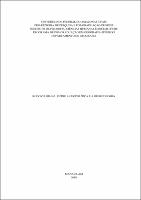| ???jsp.display-item.social.title??? |


|
Please use this identifier to cite or link to this item:
https://tede.ufam.edu.br/handle/tede/7048| ???metadata.dc.type???: | Dissertação |
| Title: | Rodovia BR-163: entre a geopolítica e a geoeconomia |
| ???metadata.dc.creator???: | Oliveira Neto, Thiago  |
| ???metadata.dc.contributor.advisor1???: | Nogueira, Ricardo José Batista |
| First advisor-co: | Théry, Hervé Emilien René |
| ???metadata.dc.contributor.referee1???: | Cruz, Manuel de Jesus Masulo da |
| ???metadata.dc.description.resumo???: | O deslocamento geográfico de parte da produção agrícola brasileira, antes concentrada nas regiões Sul e Sudeste e, atualmente, com concentrações de produção no Centro-Oeste e na região Norte do Brasil, resultou na montagem e na consolidação de uma infraestrutura de circulação terrestre para atender a uma demanda crescente de fluxos internos entre as regiões produtoras e aos complexos portuários. Nesse contexto, a pesquisa buscou compreender os arranjos espaciais e as transformações territoriais em um corredor logístico para o escoamento de commodities que envolvem a rodovia BR-163 e um conjunto de sistemas de engenharia que foram e que estão sendo implantados ao longo dos rios, com destaque para as zonas portuárias no município de Itaituba, Rurópolis, Santarém, Santana e Barcarena. Para a realização da pesquisa, optou-se em fazer um levantamento histórico e bibliográfico do processo de construção da rodovia BR-163, a atuação do Estado na elaboração e execução das políticas territoriais; outra parte consistiu-se na leitura dos clássicos da circulação, transporte e logística, incluindo também a geografia clássica e da geopolítica e geoeconomia; buscou-se realizar entrevistas no trabalho de campo, com alguns atores envolvidos, abrangendo desde os movimentos sociais até as empresas que operam as infraestruturas portuárias. A consolidação de mais um corredor de exportação de commodities agrícolas em direção à região Norte do Brasil alterou substancialmente a circulação regional com a inserção de novos sistemas de engenharia e novas rotas fluviais ao longo dos rios, tendo ainda uma convergência de fluxos rodoviários para o município de Itaituba, que passou a ser o ponto de concentração de investimentos internacionais e nacionais em infraestruturas de transportes que dão suporte aos fluxos, e este município passou a ter o maior número de portos de transbordo de carga e um conjunto articulado de infraestruturas que possibilitam a circulação. |
| Abstract: | The geographic displacement of part of the Brazilian agricultural production, previously concentrated in the South and Southeast regions and, currently, with production concentrations in the Midwest and in the northern region of Brazil, resulted in the assembly and consolidation of a terrestrial circulation infrastructure to meet to an increasing demand for internal flows between producing regions and port complexes. In this context, the research sought to understand spatial arrangements and territorial transformations in a logistics corridor for the flow of commodities involving the BR-163 and a set of engineering systems that were and are being implanted along the rivers, with emphasis on the port areas in the municipality of Itaituba, Rurópolis, Santarém, Santana and Barcarena. In order to carry out the research, it was decided to make a historical and bibliographical survey of the process of construction of highway BR-163, the State's performance in the elaboration and execution of territorial policies; another part consisted in reading the classics of circulation, transport and logistics, including also the classical geography and geopolitics and geoeconomics; it was sought to carry out interviews in the field work, with some actors involved, ranging from the social movements to the companies that operate the port infrastructures. The consolidation of another export corridor of agricultural commodities towards the northern region of Brazil substantially altered the regional circulation with the insertion of new engineering systems and new river routes along the rivers, and a convergence of road flows to the municipality of Itaituba, which became the point of concentration of international and national investments in transport infrastructure that support the flows, and this municipality now has the largest number of cargo transhipment ports and an articulated set of infrastructures that make it possible to circulation. |
| Keywords: | Rodovia BR-163 Geopolítica Geoeconomia Amazônia |
| ???metadata.dc.subject.cnpq???: | CIÊNCIAS HUMANAS: GEOGRAFIA |
| Language: | por |
| ???metadata.dc.publisher.country???: | Brasil |
| Publisher: | Universidade Federal do Amazonas |
| ???metadata.dc.publisher.initials???: | UFAM |
| ???metadata.dc.publisher.department???: | Instituto de Filosofia, Ciências Humanas e Sociais |
| ???metadata.dc.publisher.program???: | Programa de Pós-graduação em Geografia |
| Citation: | OLIVEIRA NETO, Thiago. Rodovia BR-163: entre a geopolítica e a geoeconomia. 2019. 286 f. Dissertação (Mestrado em Geografia) - Universidade Federal do Amazonas, Manaus, 2019. |
| ???metadata.dc.rights???: | Acesso Aberto |
| ???metadata.dc.rights.uri???: | http://creativecommons.org/licenses/by-nc-nd/4.0/ |
| URI: | https://tede.ufam.edu.br/handle/tede/7048 |
| Issue Date: | 15-Mar-2019 |
| Appears in Collections: | Mestrado em Geografia |
Files in This Item:
| File | Description | Size | Format | |
|---|---|---|---|---|
| Dissertação_ThiagoOliveiraNeto_PPGEOG.pdf | 7.18 MB | Adobe PDF |  Download/Open Preview |
This item is licensed under a Creative Commons License





